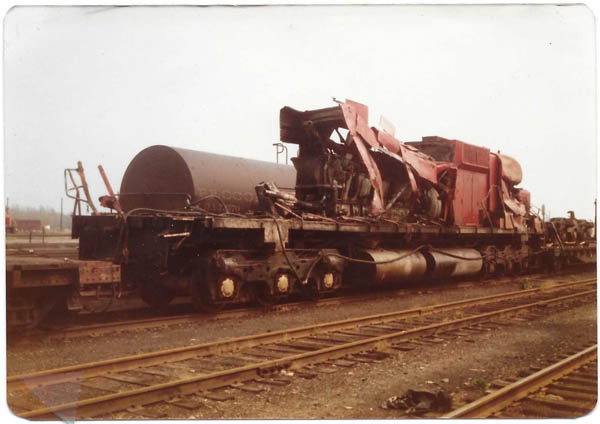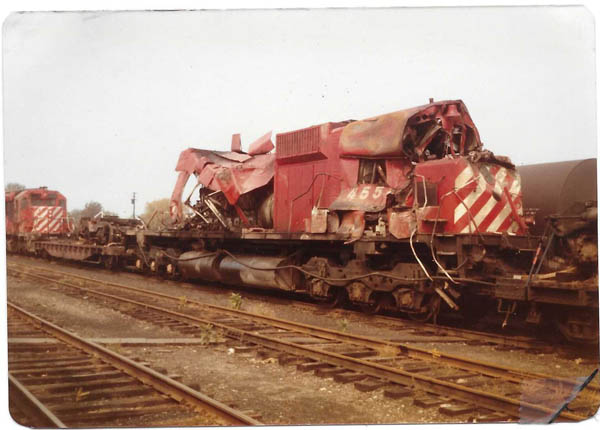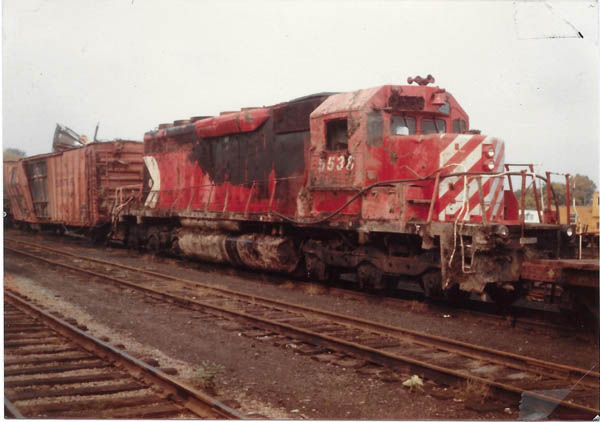Details of Railway Accidents in the Ottawa Area

1979, September 19- An eastbound freight train hits a tractor-trailer carrying logs at Wemyss Ontario, west of Perth, CPR., Belleville sub., 24 cars and 3 units derailed, minor injuries

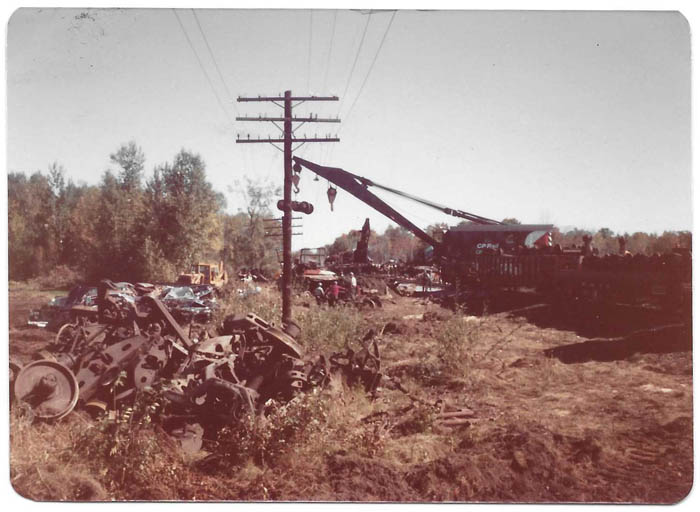
 | 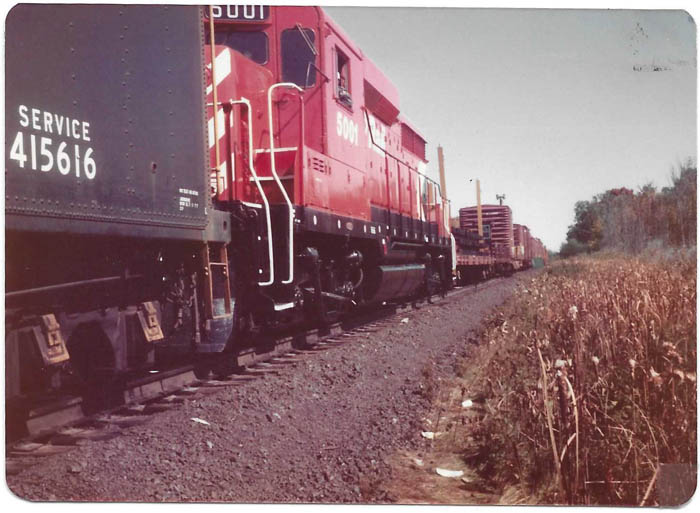 |
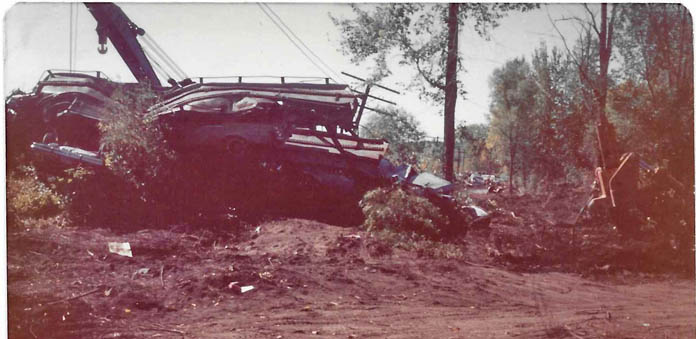 |  |
The power leaving the shop track at Toronto was SD40 5538-M630 4558 and C424 4236. However,
there were problems with the 5538 and the crew asked for the power to
be turned, and 4236 ended up leading. All 3 units were repaired at Angus and returned to service after quite a delay.
See below for more pictures by Bruce Chapman showing the wrecked locomotives at Smiths Falls
See below for more pictures by Bruce Chapman showing the wrecked locomotives at Smiths Falls
|
Ottawa Citizen 20 September 1979 Loss hit $1 million in train, truck crash WEMYSS Canadian Pacific Railway work crews are slowly picking up the pieces of a SI million train-truck collision here that sent burning wreckage over an area the size of a football field Wednesday night. Miraculously, no one was seriously injured when an eastbound Canadian Pacific freight train carrying new automobiles slammed into a northbound tractor-trailer laden with pulp logs at a level crossing about 100 kilometres west of Ottawa. The train's two engineers and the driver of the truck were able to walk away from the 7:45 p.m. accident even though the force of the impact severed the truck in two and piled freight cars one on top of the other. Train engineer Jim Colborne of Toronto was taken to Memorial Hospital in Perth with a partially-severed ear. Another engineer, Bruce Butterworth of Peterborough suffered a broken leg. The driver of the truck, Roger Lalonde, 26, of Cornwall managed to walk away with nothing more than a bad scare. Investigators are still trying to piece together the circumstances surrounding the derailment. There were no warning indicators marking the crossing along the dirt road. More than 75 CPR workmen and 42 firemen from surrounding towns rushed to the scene to find the lead engine of the train in flames and dozens of smaller fires breaking out as fuel in the automobiles ignited. Smoke billowed hundreds of feet in the air with explosions erupting from ruptured gas tanks every few minutes. The area was soaked in diesel fuel and sparks from the engine's electrical system kept igniting the fuel. The fires burned until 5 a.m. Ottawa Citizen 20 September 1979 (second article) Twisted wreckage of train strewn for 360 metres (with picture) WEMYSS (Staff) Perth resident Murray Blair, who arrived at the scene of a train-truck crash here minutes it happened Wednesday evening, said the cab of the trailer was sitting undamaged just across the tracks when he got there. "The train had hit the tractor-trailer just where the cab joins the rear section that's probably what saved the driver's life," Blair said today. "The driver told me he had driven that road every day for a month on trips to Cornwall. "He said he slowed down and put it into low gear and just as he got the cab up on the tracks he saw the train's light," said Blair. "He put his foot to the mat but he knew he wasn't going to make it, but the action of his wheels when the train hit probably saved him from being dragged back into it." Blair and his friend George Per-kins, who heard the train whistle at his home two kilometres away before the crash, found Butterworth still in the engine, his ankle broken by a log from the tractor trailer that had smashed through the window. Coburn was sitting in a nearby ditch with blood from his torn ear dripping down his face, said Blair. The train's 24 cars were strung along a 360-metre stretch of track. Some were piled 15 metres high. One of the engines turned completely around on impact. Most of the cars were carrying new GM cars destined for St. Therese, Que. Four cars normally used to transport gasoline, wax, and asbestos were empty. The train was also carrying a few carloads of auto parts. The tractor trailer was left lying in a deep ravine at the side of the track. Two auxiliary trains from Toronto f and Montreal arrived here at abou' | 5 a.m. to begin hauling the twisted wreckage off the track. More than 150 metres of ruined track must be replaced. Freight trains leaving Montreal and Toronto were delayed Wednesday and are now being rerouted on Canadian National Railway lines. Passenger service was not affected. CPR officials expect the cleanup operation and repair work for the tracks to take about another day. The track is expected to be cleared by 4 a.m. Friday Ottawa Journal 20 September 1979 Cost in millions as train rams tractor-trailer Clean-up of derailed train equipment, destroyed Corvettes and other cars continued today following a multimillion-dollar train wreck Wednesday at a level crossing 10 km southwest of Perth. A 98-car CP Kail freight train collided with a tractor-trailer loaded with logs about 7:30 p. m., in Dewitt Corners, setting off explosions and fires and ripping up 150 metres of mainline track. CP officials and police said it was a miracle no one was killed. Two men, engineer Jim Coburn of Toronto and trainman Bruce Bultcrworth of Peterborough, suffered minor injuries in the crash. The truck driver, Roger Lalonde of Long Sault, escaped unscathed. About 70 GM cars, container shipments and other freight were damaged or destroyed in the wreck, which derailed three diesel engines and 22 cars and scattered parts of Lalonde's demolished log trailer as far as 100 metres from the crossing. CN [sic] officials plan to have their Montreal-Toronto main line reopened by 4 a. m. Friday, but In the meantime traffic is being rerouted to CN's line or to CP's northern line through North Bay. No passenger traffic is affected. Engineer Coburn was treated for a partially severed left ear and head cuts while Butterworth suffered a fractured left ankle. Both were later released from hospital. Lalonde told police he had slowed down before arriving at the Churchill Road crossing, but didn't see the train and continued over the tracks. When he did see the train, he accelerated but the first of the three diesel engines struck just behind the cab. CP officials said the crossing is marked by white, reflective crossing sign, but not by signal lights. The Perth OPP detachment is still investigating the incident. The force of the impact split apart the three diesels with one landing in a swampy area about 100 metres from the track. A second diesel, entangled in Ihe wreckage, burst into flames and set off a chain reaction of exploding automobile gasoline tanks. The train, enroute to Ottawa [sic] from Toronto, was carrying no explosives or corrosive materials, although it was carrying tanker cars which one official said were not "in danger of exploding." The contents of the tankers was not disclosed. Officials at the scene estimated damage in the millions of dollars, but CP spokesmen today said damage figures will not be available for at least two weeks. One of the first persons on the scene was photographer Ted Dyke of nearby Stanleyville. "It was total chaos when I arrived," he said. "I had never seen anything like it before in my life. "The wreckage was piled, I would estimate, at least 30 feet high. Ottawa Journal 20 September 1979 (second article) His wait for firemen 'seemed like eternity' By Dave McKay Journal Reporter "Everyhing was scattered all over the place and there was no sign of life when I arrived at the scene," said Murray Blair, of Perth. Blair was one of the first persons to come upon Wednesday evening's massive train derailment just southwest of Perth. Two men were injured when the CP Rail train smashed into the side of a tractor-trailer truck at a level crossing. Damage was estimated in the millions of dollars. "There was nobody around. ..just piles of wrecked cars and logs scattered all over the place," said the Perth Courier newspaperman who discovered the wreckage while taking his dog to the veterinarian. "I've never stumbled on any thing like this before in my life. It was a real eerie feeling seeing all that metal scattered for hundreds of yards and not seeing anybody else around but me and my friend George Perkins. "The first thing George and I did was check inside of the cab of the tractor trailer which had been separated from the trailer. When we found no one we ran along the tracks looking for anyone else who might be injured. "We didn't know at the time the driver (Roger Lalonde) had gone to a nearby farmhouse to get help. "Then from the other side of the derailed flat cars we heard someone pleading for help. We ran over and found one of the trainmen sitting on an embankment by the wreckage with blood oozing out the side of his head. "The fellow (Jim Coburn) asked me if his brain was sticking out because all he could feel was the blood dripping down (he side of his face. I didn't tell him how bad it was but his ear seemed to be hanging by a thin piece of skin. "He tofd us he would be all right and asked us to go and check on a co-worker (Bruce Butterworth). "We spotted him within a few minutes in one of the derailed diesels but we couldn't get to him because of all the debris. "The man (Bu(terworth) was worried about the explosions but we told him he was safe until firemen arrived, he said he was feeling weak because of a log that had smashed through the cab window and hit his leg." Blair said it seemed like an eternity before firemen arrived and began rescue operations. Another witness. Ted Dyke, of nearby Stanleyville arrived at the scene shortly after Blair. "All those Corvettes burning ... I couldn't believe my eyes. All those other cars that looked liked someone had taken a giant can opener to them . . . man was it a mess. You feel so helpless when you look at a disaster scene like this," said Dyke. Dyke, a photographer, started taking pictures of what he described as an "ugly scene." "There were at least two dozen cars on fire with twice that many wrecked. Debris was piled at least 30 feet high and I had to stand on lop of some of it to lake my pictures. "The fire was punctuated with explosions from the gasoline tanks on the cars. I spotted one of the diesels at the bottom of the pile," continued Dyke.' "When I left cars were still burning and exploding while firemen were attempting to put out the names by pouring water and foam on them. "I guess it will be a couple of weeks before the mess is cleaned up." Ottawa Citizen 21 September 1979 It didn't matter that the Cadillac Seville was worth $14,000 it was dragged to a nearby field along with other hunks of metal which were once luxurious automobiles. Corvettes, Trans Ams, Oldsmobiles, and Cadillacs, part of a shipment of 108 new cars en route to General Motor's plant in Ste. Therese, Que., were all subjected to the same treatment during the clean-up operation after Wednesday night's train wreck near Perth. They were dragged off the main line into nearby fields to make way for repair crews and new rails. More than 100 men had been called in from Montreal, Toronto and Ottawa to help with the massive cleanup. Equipped with two heavy-duty cranes, two diesel bulldozers, a front-end loader and steel cables, the men cleared away 24 railway cars, most of them loaded with the new automobiles, from a 160- metre stretch of track 13 kilometres west of Perth. The line was cleared by midnight about four hours ahead of schedule. The automobiles, all full and midsize models worth between $8,000 and $14,000, were part of the cargo of a 98-car Canadian Pacific freight train which rammed into a tractor-trailer laden with logs. By mid-afternoon, the crews had cleared away three railway cars of GM parts and empty container cars used to carry wax, gasoline and asbestos. But they were only beginning to work on the removal of the automobiles. The two 225-tonnes cranes brought in from Montreal and Toronto were needed to move the three-tier railway cars which were strewn about on their side following the impact. An empty three-tier car weighs approximately 22.5 tonnes with its cargo adding another 22.5. The cranes lifted the wrenched railway cars free from the rails which were bent into pretzel-like scraps of metal by the impact of the derailment. The bulldozers then used steel cables to drag the mangled heaps away from the site. As the railway cars were dragged to the side, safety chains which secured the automobiles onto the cars began to snap, letting the cargo topple to the ground. Windshields popped, gas tanks were ruptured and cars flattened as once luxurious models of North American status were reduced to indistinguishable scraps of metal. A spokesman for CP Rail said the company would try to salvage what it could but clearing the track was the main priority. The charred remains of a diesel engine, bearing the familiar CP Rail logo, was one of the first pieces of equipment to be cleared from the rest of the rubble. Once a mighty driving power, it was reduced to a mere scrap of metal, waiting for its final ride to the scrap yard. Ottawa Citizen 21 September 1979 (second article) Lucky trucker tells of escape It was getting dark and Roger Lalonde had to get the heavy load of pulp wood just cut near Sharbot Lake to a Cornwall paper mill. He decided to take the back roads to avoid the highway traffic. The short cut brought the 23-year-old Long Sault man to a level railway crossing at Dewitt Corners, about 13 kilometres west of Perth and within metres of death. At 7:35 p.m. Wednesday, a 98-car CPR freight train slammed into Lalonde's tractor trailer at 80 kilometres per hour. In a few horrifying minutes the train's three diesel engines lunged burning into the ditch and 24 railway cars, many of them tri-level automobile carriers, piled into each other in a mass of flames, explosions and twisted metal. Amid the carnage, Lalonde emerged from the cab of his truck totally unscathed. "I guess I'm pretty lucky to be here," he said Thursday, back with his family at his Long Sault home. "It all happened so fast, I didn't know what hit me. When I started to cross the tracks there was just no train there. Then I saw the light coming up fast. " Witnesses say Lalonde survived only because the lead engine severed his vehicle dead on the connection between the cab and the flatbed trailer. Two CPR engineers were injured when the diesel derailed and plunged into marshy ground beside the track. But there were no serious injuries. Lalonde, still shaken by the experience, said Thursday he had used the gravel road frequently since he began the run from the Sharbot Lake logging operation to Domtar Ltd. in Cornwall last month. While there are no railway lights at the crossing, he never thought it particularly dangerous. "I was only going about one mile an hour across the tracks. I just didn't see the train until it was right on me," he said. They definitely need warnings there." Lalonde, who bought his International tractor and flatbed trailer just a month and a half ago for the family business, doesn't know what the future holds. "I guess I just have to sit and wait for the insurance people." The Perth OPP detachment is still investigating the accident. Meanwhile CPR officials are tallying the damages which may reach $2 million. General Motors of Canada Ltd., which had 108 brand new automobiles and three box cars of components on the train, has sent its own investigators to survey the ruins. The GM cars - all full and midsize models - were all from the Windsor, Ont., plant en route to GM's plant in Ste. Therese, Que., where more cars would be added to the train for distribution to points cast, said GM spokesman Nick Hall. Hall said the company can't even estimate the damages yet until the mess has been cleared away, but he wasn't optimistic. "Usually in cases like this, very few of the cars ever make it to the streets. Even if they appear undamaged, they have to be impounded and checked over very carefully," he said. "Most of them will be insurance writeoffs and used for parts or repaired and turned over to GM's employee training centres." While a shipment of GM cars was damaged in a train derailment near Thunder Bay last July, Wednesday's mishap appeared to be one of the most serious for the company, said Hall. Spokesmen for both GM and CPR said the companies have extensive insurance coverage. Ottawa Journal 21 September 1979 Train wreck damage set at $3-$5 million Insurance adjusters at the scene of Wednesday's derailment of p 98-car CP Rail freight train say damage estimates range from $3 million to $5 million. Three diesel engines and 22 cars carrying about 70 new GM automobiles were destroyed after leaving the track about 7:30 p. m in Dewitt Corners, 10 kilometres southwest of Perth, following a collision with a tractor-trailer truck loaded with logs at a level crossing. CP Rail officials and police said it was a miracle no one was killed, although engineer Jim Coburn of Toronto and trainman Bruce Butterworth of Peterborough remain in hospital and are reported in stable condition. Coburn received emergency surgery to repair an almost severed left ear while Butterworth suffered a fractured left ankle. Truck driver Roger Lalondc of Iong Sault escaped uninjured. Impact of the collision split the tractor from the trailer while the train continued for about 1K0 metres before derailing and bursting into flames. Burning deisel fuel spread to the tanks of the automobiles, setting off a chain of explosions. It took firefighters more than 10 hours to extinguish the blaze. CP Rail officials say it will be at least another week before all the debris is cleared from the area Ottawa Citizen 9 January 1980 Driver cleared in crash PERTH (Special) The driver of a logging truck involved in a $2-million accident with a CPR, freight train last fall was found not guilty of a charge of careless driving in provincial court here Tuesday. Roger Lalonde, 24, of Cornwall, was hauling a load of logs last Sept. 19 when the spectacular accident occurred at a levd crossing 1 1 ki- lometres southwest of here. Although his tractor-trailer was cut in half, Lalonde walked away without a scratch. A number of trainmen were injured in the collision. Seventy-two late model cars were destroyed in the accident and fire from the train burned for eight hours. From Steve Kmit June 2020 Just before my time. I started June 08, 1981. I did work with Jim Coburn several times on the Belleville Sub. He lost part of one ear in the crash. The cab was full of logs. I believe it was the 4236. Bruce Butterworth the H.E Brakeman was a real gentleman; a soft spoken guy. He was never able to return to the running trades. He became a Labour Relations officer and finished his career there. He only passed on a year or 3 ago if I remember correctly. From Bruce Chapman June 2020 You can see that the 4236 is heading west after the eastward derailment. I received a call from Bill McVean who was the trainman in the van of that train (either #916 or #942) with conductor Bill Swinarton. There was a terrific run-in when they hit the truck, then a run-out; he walked up to the head-end and the engineer Coburn was there in shock with part of his ear off. A car came to the blocked crossing and Bill asked them to watch Coburn to make sure that he didn’t wander off. Bill eventually was taken to either the Perth or Smiths Falls hospital where he saw Butterworth and Coburn. An e-mail from Mike Couse: I worked with Bruce Butterworth when he was a conductor and I was a trainman, and also later with him in Eastern Region Labour Relations in Toronto from 1986 to 1988. I worked a lot with Jim Coburn on various Toronto Division train assignments. Jim was one of 3 brothers: Frank, Jim and Jack, who were all District 3 Conductors and Trainmen out of Toronto. I worked with Jim and Jack too. Both Coburn and Butterworth were lucky puppies in that derailment. Steve Kmit’s (I was one of his trainers in Toronto when he started) info is correct. Bruce never worked again in train service after the derailment and was picked up as an Assistant Supervisor of Labour Relations for the Eastern Region in Toronto. The untold story after the derailment that the shortcut taken by the Quebec truck driver was deliberate. He wanted to avoid the sales on Highway 7 at Glen Tay so he took the detour, and apparently the police knew all about this detour. Then I got a call from Ray Kennedy in Toronto. He said that Coburn was a pilot in WWII in Europe and survived that. When Coburn saw that a collision was imminent, he hid under the middle seat on the 4236 where the head-end brakeman would normally sit, and that’s what saved his life. Had he been in the 5538, there was no centre seat, just the 2 on the left hand side for the brakeman and fireman. These pictures taken by Bruce Chapman September 29, 1979 at Smiths Falls 
|

Return to Main Page of Railway Accidents
Updated 14 June 2020

